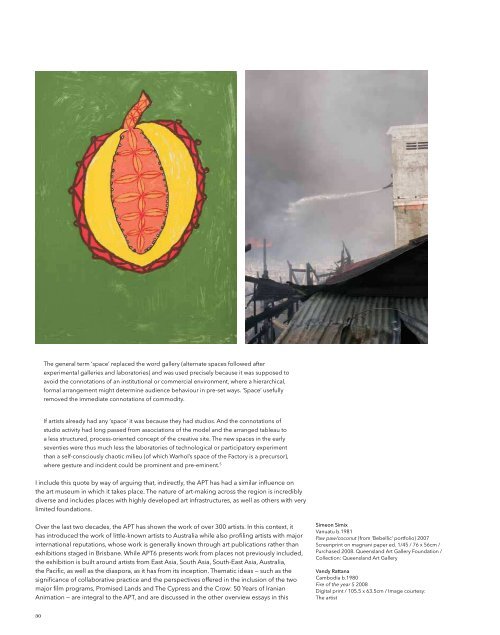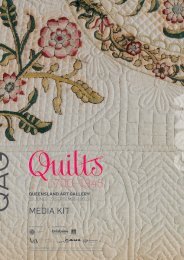Queensland Art Gallery - Queensland Government
Queensland Art Gallery - Queensland Government
Queensland Art Gallery - Queensland Government
Create successful ePaper yourself
Turn your PDF publications into a flip-book with our unique Google optimized e-Paper software.
publication. The discrete projects — such as The Mekong, Pacific Reggae: Roots Beyond the<br />
Reef, the works from North Korea (DPRK), and the thematic film programs — each concentrate<br />
on particular regions to present more in-depth perspectives on art history and contemporary<br />
ideas. For example, The Mekong uses the river as metaphor for the movement and exchange<br />
of knowledge. As Rich Streitmatter-Tran, co-curator of The Mekong states:<br />
The Mekong region is often referred to through a variety of organisational frameworks including<br />
historic–cultural areas, sociolinguistic zones, and by the borders of the nations themselves. It has<br />
always been a shifting territory — an ebb and flow of conflict and cooperation, modernisation<br />
and preservation, exploitation and conservation. Each struggle can be found documented in<br />
the arts, whether in historical artefact or in the contemporary work featured in APT6. 6<br />
There is always more to be said about contemporary art and art-making in Asia and the<br />
Pacific and, as we approach the second decade of this century, the economic, social, political<br />
and cultural dynamics of the region — and its relationships with the rest of the world — are<br />
more intense than ever. Every three years, the APT revisits this territory. Within Brisbane and<br />
internationally, this exhibition marks a point of concentration and deliberation valued by many.<br />
To return to Storr’s apt observation, ‘a good exhibition is never the last word on its subject’.<br />
The general term ‘space’ replaced the word gallery (alternate spaces followed after<br />
experimental galleries and laboratories) and was used precisely because it was supposed to<br />
avoid the connotations of an institutional or commercial environment, where a hierarchical,<br />
formal arrangement might determine audience behaviour in pre-set ways. ‘Space’ usefully<br />
removed the immediate connotations of commodity.<br />
If artists already had any ‘space’ it was because they had studios. And the connotations of<br />
studio activity had long passed from associations of the model and the arranged tableau to<br />
a less structured, process-oriented concept of the creative site. The new spaces in the early<br />
seventies were thus much less the laboratories of technological or participatory experiment<br />
than a self-consciously chaotic milieu (of which Warhol’s space of the Factory is a precursor),<br />
where gesture and incident could be prominent and pre-eminent. 5<br />
Endnotes<br />
1 I would like to acknowledge Runa Islam for her wonderful work The Restless Subject 2008, which effortlessly<br />
captures the complexities involved in the act of ‘seeing’.<br />
2 Robert Storr, ‘Show and tell’, in Paula Marincola (ed.), What Makes a Great Exhibition?, Philadelphia Exhibitions<br />
Initiative, Philadelphia, 2006, p.14.<br />
3 Hou Hanru, interviewed by Robert Leonard, ‘The biennale makers’, <strong>Art</strong> & Australia [APT6 special issue], December<br />
2009 [forthcoming].<br />
4 Sharmini Pereira, ‘The Asia Pacific Triennial: A forum’, in ‘21st century art history’, The Australian & New Zealand<br />
Journal of <strong>Art</strong>, vol.9, no.1/2, 2008–09, p.210.<br />
5 Sandy Nairne, ‘The institutionalization of dissent’, in Reesa Greenberg, Bruce W Ferguson and Sandy Nairne,<br />
Thinking about Exhibitions, Routledge, London, 1996, p.396.<br />
6 Rich Streitmatter-Tran, ‘Mapping the Mekong’, The 6th Asia Pacific Triennial of Contemporary <strong>Art</strong> [exhibition<br />
catalogue], <strong>Queensland</strong> <strong>Art</strong> <strong>Gallery</strong>, Brisbane, 2009, p.128.<br />
I include this quote by way of arguing that, indirectly, the APT has had a similar influence on<br />
the art museum in which it takes place. The nature of art-making across the region is incredibly<br />
diverse and includes places with highly developed art infrastructures, as well as others with very<br />
limited foundations.<br />
Over the last two decades, the APT has shown the work of over 300 artists. In this context, it<br />
has introduced the work of little-known artists to Australia while also profiling artists with major<br />
international reputations, whose work is generally known through art publications rather than<br />
exhibitions staged in Brisbane. While APT6 presents work from places not previously included,<br />
the exhibition is built around artists from East Asia, South Asia, South-East Asia, Australia,<br />
the Pacific, as well as the diaspora, as it has from its inception. Thematic ideas — such as the<br />
significance of collaborative practice and the perspectives offered in the inclusion of the two<br />
major film programs, Promised Lands and The Cypress and the Crow: 50 Years of Iranian<br />
Animation — are integral to the APT, and are discussed in the other overview essays in this<br />
Simeon Simix<br />
Vanuatu b.1981<br />
Paw paw/coconut (from ‘Bebellic’ portfolio) 2007<br />
Screenprint on magnani paper ed. 1/45 / 76 x 56cm /<br />
Purchased 2008. <strong>Queensland</strong> <strong>Art</strong> <strong>Gallery</strong> Foundation /<br />
Collection: <strong>Queensland</strong> <strong>Art</strong> <strong>Gallery</strong><br />
Vandy Rattana<br />
Cambodia b.1980<br />
Fire of the year 5 2008<br />
Digital print / 105.5 x 63.5cm / Image courtesy:<br />
The artist<br />
30 31
















